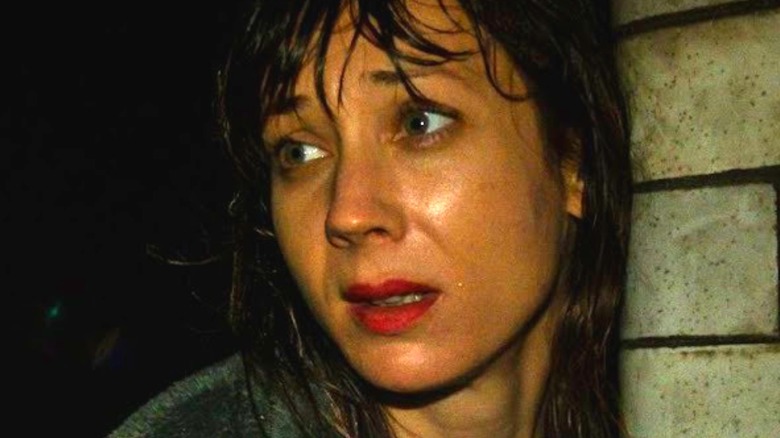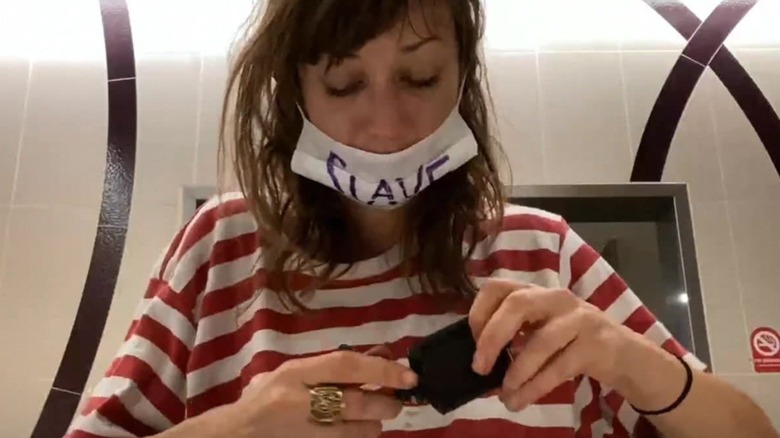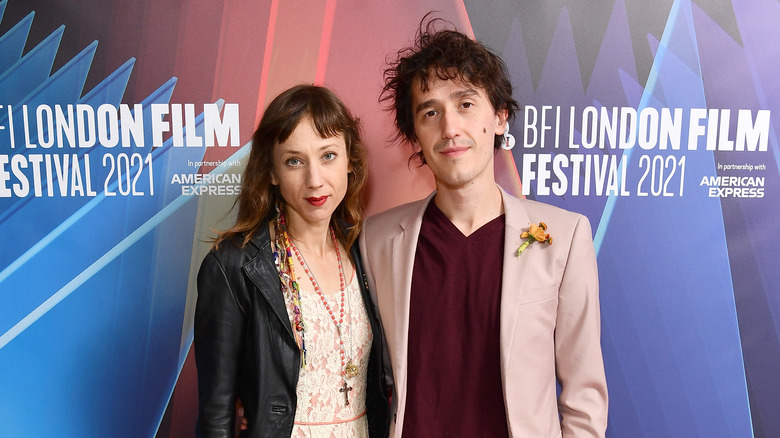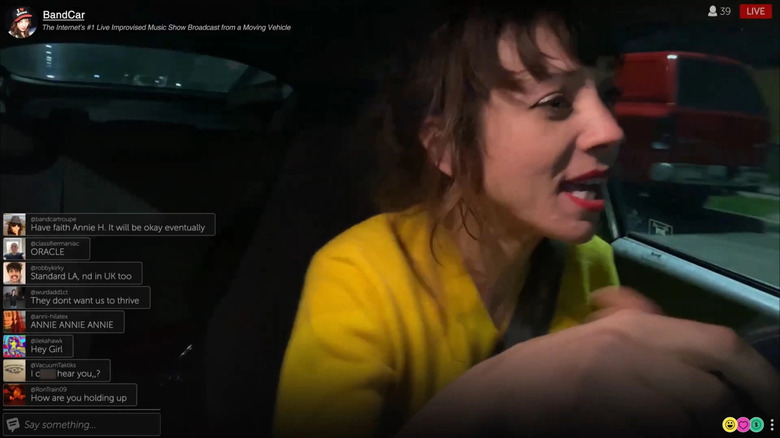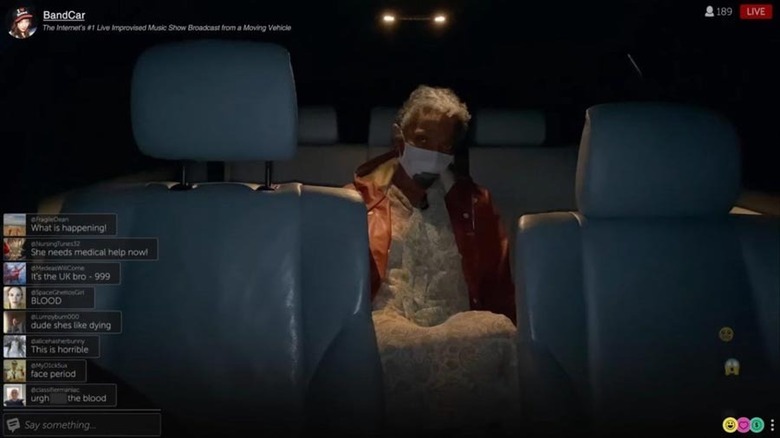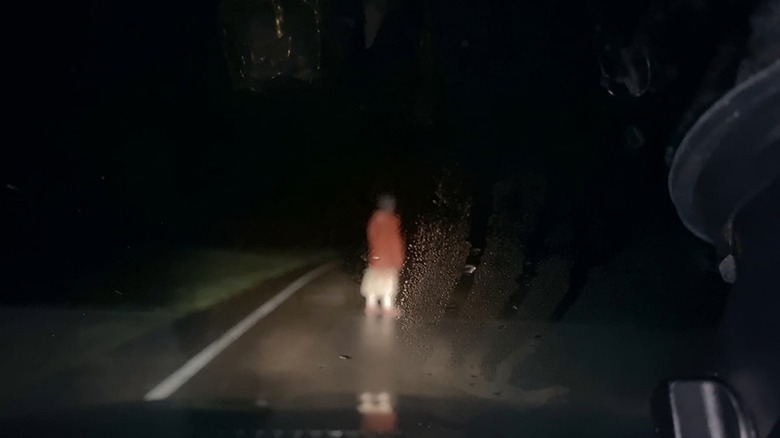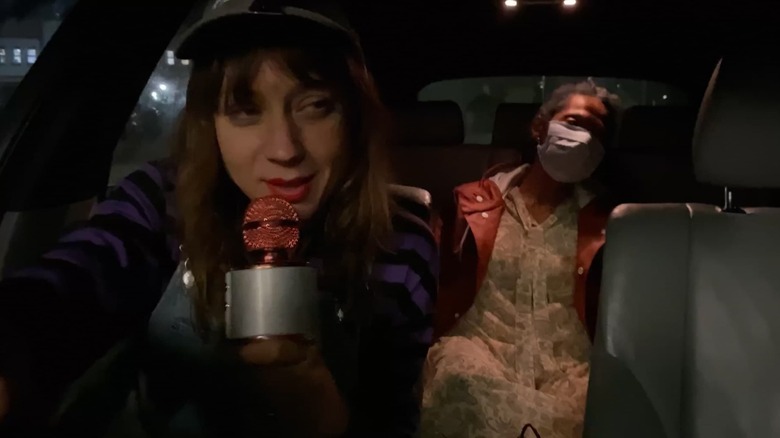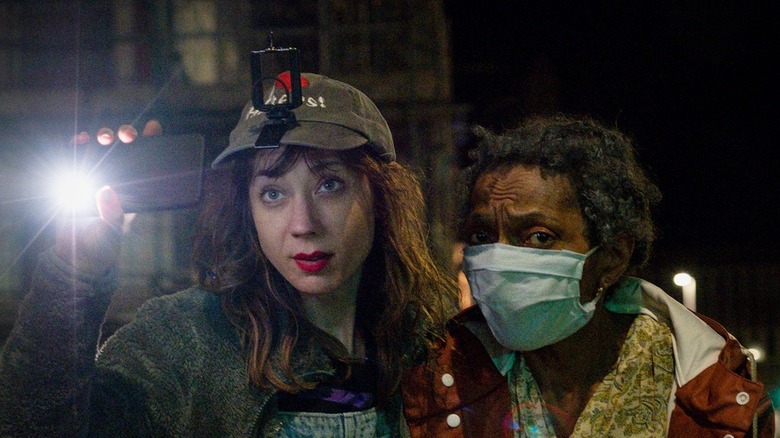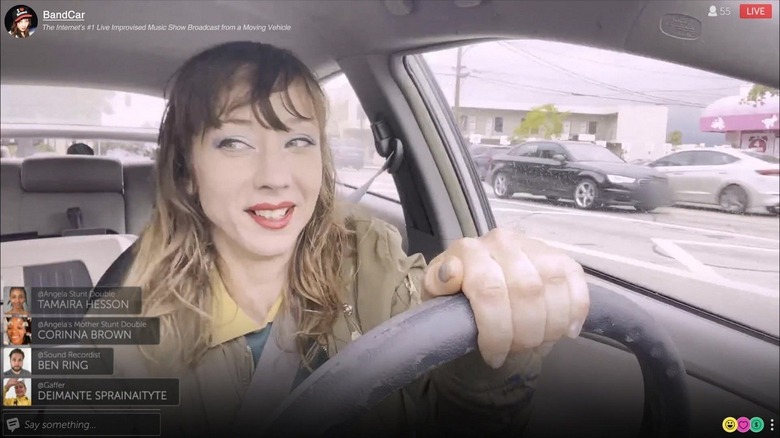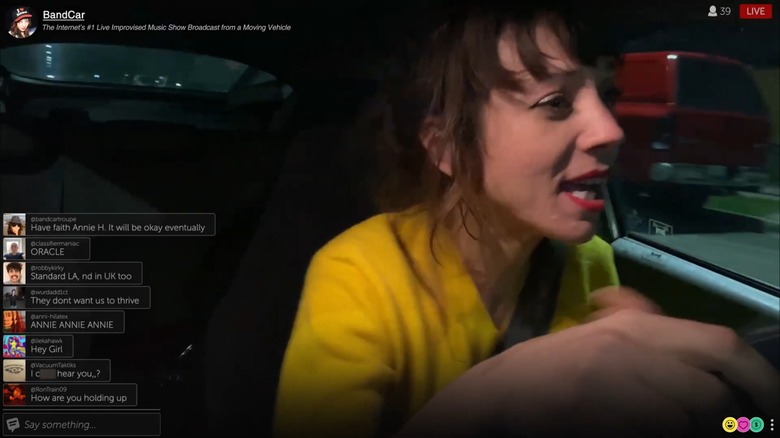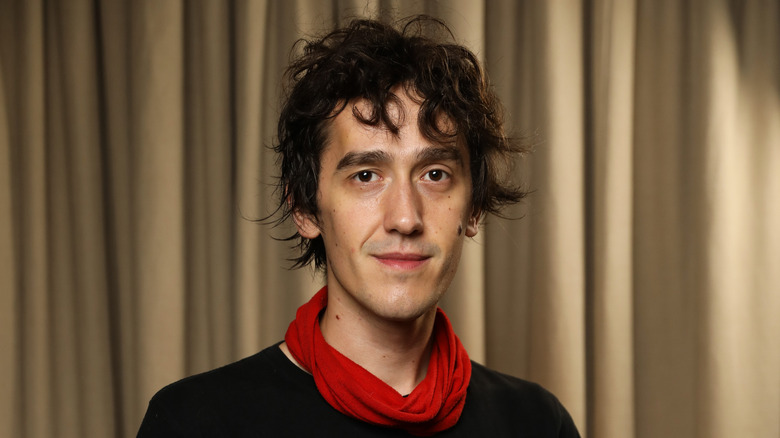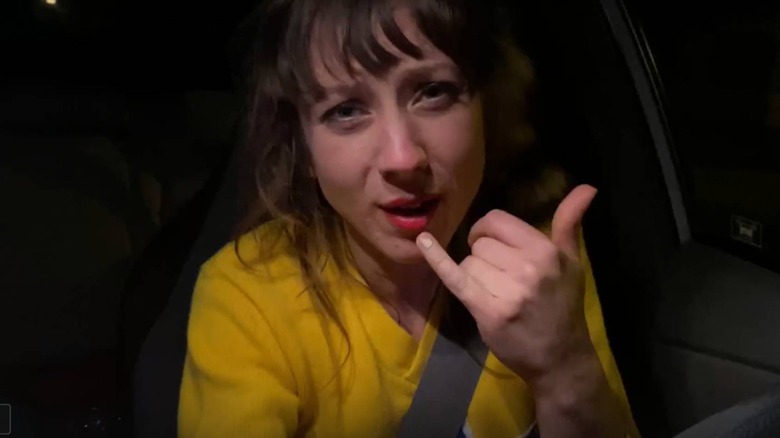The Ending Of Dashcam Explained
During the COVID pandemic, filmmaker Rob Savage made two horror films in the popular found footage style, "Host" and "Dashcam." The first was released at the height of quarantine as one of the best horror movies of 2020, while the latter premiered in 2021 after society had begun to open back up. The disparity of what life was like between those years is also reflected in the movies, because "Dashcam" is entirely different in almost every way from its predecessor. While the terror in "Host" is confined within an almost claustrophobic setting, "Dashcam" was like the chaotic burst of energy most people felt after finally feeling free to leave their homes.
The constant action of the film is not hard to follow in the sense that there's too much complexity. But the movie does quickly sweep viewers off their feet and pull them through a rough ride with no time to ask why the obnoxious protagonist is on a path leading straight into absolute madness. To fully understand everything that is happening in "Dashcam," Savage recommends watching the film more than once, but for more help, here's a guide with insight on Annie Hardy's horrifying night.
The goal was to be as extreme as possible
Rob Savage's first pandemic era horror flick, "Host," is a slow burn where the terror builds gradually until the frightening climax. For his next film, shot immediately afterward, the director wanted to go in the complete opposite direction and create an homage to the campy gorefest "The Texas Chainsaw Massacre 2." He explained to NME, "I wanted this movie to be in the vein of those '80s sequels that take a classy original movie and make a very un-classy, big, loud, kind-of-comedic sequel."
To achieve his vision, Savage sought to make the film extreme in every possible way. "I just wanted this movie on every front to be a little too much," he told Den of Geek. "You know, a bit overwhelming and maybe a bit too much to take in one viewing, and also just like anxiety inducing the whole way through." From the over-the-top attitude of Annie Hardy's protagonist character to the highly graphic violence, no one can claim that the filmmaker failed to achieve his goal.
Annie Hardy acted as a fictional version of herself
The main character of "Dashcam," Annie Hardy, is highly controversial from the get-go. Not only is she a very vocal vaccine denier, but she's consistently unable to have consideration for the people around her, including her close friend Stretch and his girlfriend, Gemma. And none of that ever really changes as the tale progresses.
One significant detail to the character might also be rather confusing to some viewers of film who recognize the same Annie Hardy as the star of the real life web show "Band Car" and the lead singer of the band Giant Drag. Once Rob Savage was introduced to her unique style of live stream freestyling, he and co-writer Jed Shepherd decided to write the story around her flamboyant personality. At the same time, the character was always meant to be an entirely fictional spin on Hardy's persona. As the actress explained bluntly to NME, "I'm [playing] an alt-right version of myself. I'm not as much of a d***head myself."
The entertainer knew that audiences would despise the character and almost rejected the role for that reason. She assumed there would be some confusion over who she really was as a person, which did indeed end up being the case. "Everybody has black-and-white thinking these days, and ['Dashcam' and her character] fall into a grey area," Hardy elaborated. "The character's name is my name, but there's some aspects and things [in the film] I would never say [in real life]. It's a movie. But people don't understand the whole concept of movies anymore, they think this is real life."
The protagonist had no interest in the plot
When Rob Savage was writing "Dashcam," he wanted to tell the story in a way that was intentionally vague, without much explanation for the plot. Not only did the approach complement the overall chaotic nature of the film, but it also made sense to show events in that way because they were through the perspective of Annie Hardy.
As Savage explained to "Dread Talks," the idea was never for the protagonist to intentionally drive the story forward. "This character isn't the kind of person who's gonna give an exposition dump and talk about the plot," the director said. "Like, she's not going to be interested in the plot. She's just going to want to get the f*** out of there. So, it became this fun thing of like a horror movie where the main character isn't interested in the plot, and so, she's kind of staggering into these situations with very little investment in how they connect together."
The film is meant to be watched twice
There is a good chance that many first-time viewers of "Dashcam" may be left wanting more by the end of the film, which was done on purpose. Events happen so quickly that there's no time for explanation. On the other hand, if the audience is not exclusively focused on the intense action, they will notice that the commenters on Annie Hardy's live stream provide key answers to questions about the plot.
But the filmmakers did not expect people to pay much attention to the comments the first time around, as Rob Savage explained to Den of Geek. "The idea is that there'd be enough to intrigue you to come back for a second viewing where you could follow that," Savage said. The director then emphasized that the details would be worth it, adding, "The commenters are really being like armchair detectives the whole way through, they actually crack the plot. So, if you're interested in feeling the movie you can watch what's on screen, if you're interested in understanding the movie, then the commenters kind of figure it out."
The story was pitched as The House of the Devil in a car
Filmmaker Rob Savage wanted to keep the story of "Dashcam" as simple as possible and make a fun, roller coaster type of horror flick that keeps the audience on edge all the way to the climatic finale. With that in mind, the filmmaker was well aware that he was not making the most original movie. On "Dread Talks," he elaborated, "We pitched it as '[The] House of the Devil' in a moving car, so it's not new territory. But then, as soon as you throw a character like Annie in, the decisions she makes and the reactions, the kind of unconventional way she acts when she's scared, or threatened, or fighting back, it just makes all those scenes feel a bit more fresh."
The end product is exactly what was intended, with the characters constantly thrown into a new situation more extreme than the last. Even when the malicious desires of the satanic cult are suddenly shown, Annie Hardy has absolutely no time to ask questions and simply must react to survive and escape the hellish environment she finds herself in.
Angela's staples saved Annie's life
In the second half of "Dashcam," Angela becomes such a horrifying monster that it may be easy to forget how incredibly fragile she appeared when first introduced in the film. That aspect of the story was one of the first that Rob Savage and co-writer Jed Shepherd came up with while writing the script, as Savage told NME. "We threw ideas around and came up with Annie picking up an old woman who she has to ferry from one point to the next," the director explained. "Something resonated, the old woman being both the victim and the antagonist. At this time, the end of 2020, Boris Johnson was saying, 'Don't go outside or you'll kill grandma.' It felt like a really tongue-in-cheek thing to do."
Even though the sight of her mother being thrown across the diner was the first hint of Angela's supernatural abilities, it was not until the staples were removed from her mouth that all hell broke loose. From then on, the seemingly geriatric lady goes on a murderous rampage to take out everyone in sight. Therefore, the staples were literally the only thing that saved Annie Hardy's life while they were alone in the car together at first.
The commenters discovered Angela's identity
As the various commenters watch Annie Hardy's horrific ordeals during "Dashcam," they gradually piece together what is happening, with one of the first major revelations being the true identity of Angela. Right after the crazy lady hunting Hardy and Stretch claims to be the old woman's mother, it's one of the viewers, @yellowhammermaker, who confirms that she is, in fact, a teenage girl. Their proof is a source which says, "Angela Enahora, 16, was last seen walking home from school." Earlier in the story as the group was fleeing from the diner, it was this same armchair detective who correctly predicted that the two women were related due to their resemblance.
At the point when Angela's full name is revealed, the commenters also begin to speculate much more about what Hardy is dealing with, which alludes to the cabal of demon worshippers responsible for the live streamer's night of absolute horror. First, @SharkBubbleBite writes, "Shes [sic] in some cult or something," when talking about Angela's crazed mom. Shortly after, when the creature formerly known as Angela brutally slays her own mother, @fire&br1m comments, "demons satanmists," followed by, "get right with god." These posts, along with earlier statements about demons and Satan, prove that the commenter was right about the occult being involved in some way.
Annie Hardy was meant to be the cult's next victim
Near the beginning of "Dashcam," Annie Hardy is willing to transport Angela across town after she is offered a decent amount of cash in return for carrying out the task. She's then given the address of the destination, which she writes on her arm as 214 Timberline Way. It is easy to miss at first, but the commenter @yellowhammermaker points out that something is not quite right with an ominous post that they could not find the address on Google Earth, nor in any other searches.
Much later in the finale, the protagonist seeks refuge in a seemingly unoccupied residence after barely surviving the murderous rampage of Angela. While doing her characteristic freestyling in the home, Annie discovers to her horror that she is within 214 Timberline Way. Before she's able to process this terrifying information, she encounters the members of the demonic cult that was not just eagerly waiting in anticipation for Angela's arrival, but also for Annie as well.
The climactic scenes occur in rapid succession, so Rob Savage provided a bit more explanation to Den of Geek. "Angela is actually this missing child who went missing months before and the demon got put inside her and it shriveled her up and turned her into an old woman," the director revealed. "This cult are looking to put it into Annie as the next host."
Commenters were right about the abducted people
Before Angela's true identity is revealed, the in-movie commenter @yellowhammermaker has already shown that they're the best internet sleuth of the commenters by finding out that many cases of missing individuals have been reported near the café where Annie meets the old woman. At first, the commenter makes the eerie post that "Lots of UFO sightings reported near here," followed by the statement, "Googling missing people nearby," once Angela is introduced. Since the woman has already aged dramatically, the poster is unable to determine her identity at that time, but then makes the scary comment, "Lots of kids missing round there tho."
The abductions of local people are confirmed at the end of the film once Annie discovers all of the abandoned vehicles at the hideout of the Satanic cult. The protagonist is desperately attempting to escape, and gets out of the area before long, but it's likely that the possessions strewn about belong to more victims than just Angela and Annie.
Angela was drained by the demon parasite within her
Near the end of "Dashcam," the audience finds out that Angela has somehow transformed from an innocent teenage girl to an aged monster with supernatural powers. However, the horrifying details of what has happened to her are not revealed until the very end, when the demonic parasite living within her graphically explodes out of her body to free itself and chase Annie.
The freakish creature was not only behind Angela's extraordinary abilities and bloodlust, but it's also why she had turned into an elderly woman. Rob Savage explained to Den of Geek, "The mythology that we had was like there's this cult which worships this ancient demon that needs young bodies to inhabit, like a hermit crab. The problem is it just uses them up really fast and then it needs another one."
Once the parasite lost possession of Angela, the demon is no longer the formidable threat it had been. The director continued, "When it's out of its shell, and out of its human host, it's a little weaker and slimier and embryonic and basically, it's something that Annie can bash in with a keyboard."
The commenters have character arcs too
Even though the near-constant action throughout "Dashcam" is the most important aspect of the film, the filmmakers also put a considerable amount of effort into the creation of the "live" comments often seen on the left hand side of the screen. Not only is there a considerable amount of input from the commenters, but the creative team even fleshed them all out as actual characters as well.
When interviewed on "Dread Talks," Rob Savage talked about what it took to come up with so much chatter. "We spent a kind of sleepless couple of weeks, me and the producer, just living on Red Bull and putting together thousands and thousands of comments creating these characters," he said. "Every one of those characters has a personality and has an arc." The project was so large that producer Douglas Cox also heavily contributed, telling Deadline, "There's a wealth of layers in those comments. Lots of different characters [making the comments], most of which are living rent-free in my head to this day."
The protagonist never redeems herself
It's totally understandable why Annie Hardy, the actor, was hesitant to take on the starring role in "Dashcam," because her character remains mostly a terrible person throughout the film. Yet unlike the characters of many horror stories, she still manages to survive as the protagonist without ever truly redeeming herself in the end or facing any sort of poetic justice for the rotten way she treats the people around her.
Rob Savage's goal was to have the main character be one of the most unconventional parts of the story, so he was not surprised that many viewers could not stand her. As he told Deadline, "A lot of people watch this movie and watch her and find her unlikeable, hard to deal with, and because you're watching a horror movie you think very much in terms of like, 'Do I want to see this person eaten by a demon or not?' A lot of people are watching it being like, 'I hope this b**** f****** dies.'"
